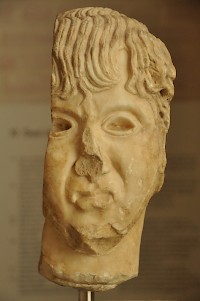Aristaenetus
Aristaenetus: Late Roman or Early Byzantine author of a collection of fictional, literary love letters.
Biographical information

The collection of love letters by a certain Aristaenetus is a curiosity from ancient Greek literature. The modern title, Erotic Letters, does not really cover their contents, but love is undeniably an important theme. They are interesting in more than one way. For example, we have hardly any idea who this enigmatic Aristaenetus was. Nor do we know where he used to live. Even stranger: it is far from certain that Aristaenetus was the author’s name: it is the name the sender of the first (fictional) letter uses for himself, but whether the author was also called Aristaenetus, remains open to debate.
Possibly, the writer was from Constantinople, because in one of the lettersnote he mentions “the New Rome”, the original name of that city, given to Byzantium by the emperor Constantine the Great at the city’s refoundation in 330 CE. Of course one does not have to live in a city to know its name.
Sometimes, it is assumed that the author lived around 520 CE. This is based on the observation that in one of the letters,note there appears to be an allusion to the way in which the consul Justinian, the future emperor (r.527-565), could marry Theodora: by changing the marriage laws. Like this empress, about whom there were many rumors, the protagonist of this letter gave up her life on the stage and in a brothel, and became a model wife.
In short, we have an author with a name we can just guess, who may or may not have lived in the age of Justinian, in a city we are not really certain about. Another approach is to look at the work itself and search for a literary context.
Literary context
The sixth century CE witnessed a revived interest in ancient Greek antiquity. The Byzantine authors enthusiastically practiced neglected literary genres again. Aristaenetus appears to represent the renewed interest for epistolography, the highly intellectual art of letter-writing. His love letters are based on authors such as Alciphron, Achilles Tatius, and (pseudo-)Lucian, who had written similar letters, although Aristaenetus is rather prudish. His personages send kisses, press hands, incidentally touch a breast – and that’s about it. Homosexuality, both male and female, are absent.
Other sources of inspiration are Plato’s dialogues, the conversations of Lucian, and the comedies of Menander. Aristaenetus loves to quote proverbs and proverbial expressions.
As was customary in the New Comedy and in Hellenistic epistolography, the names of the writers and the addressees offer a clue about the contents of a letter. Some examples: a lover of beauty can be called Philokalos, a musician Eumousos, a painter Philopinax.note Twice, Aristaenetus writes to his own sources of inspiration: Alciphron and Lucian.note Female addressees have the names of hetaerae and/or personages from the New Comedy, like Glycera, Doris, Chrysis, and Philinna. His love letters are, in short, a highly intellectual game.
Editions
Aristaenetus’ letters have been preserved in one manuscript only, the Vindobonensis philologicus graecus 310, and consist of two books, containing 28 and 22 letters. (From another source comes a fragment in which a writer advises his friend to take flight as quickly as possible.) The Vindobonensis manuscript contains short summaries for each letter, which were added later; the names of the addressees are mentioned without the “salute” or “dear” we would expect.
The first edition was by the Hungarian humanist János Zsámboky ("Johannes Sambucus"; 1531-1584) and published in Antwerp in 1556. Two years later, Cyre Foucault translated the letters into French. In the seventeenth and eighteenth century, Aristaenetus was studied diligently, but he fell from favor when the neo-humanist scholars and classicists qualified his letters as pastiches without literary value.
The love letters have been translated into English, French, Italian, Dutch, and German. The most recent edition of the text is the one in the Collection Budé: Aristénète, Lettres d’amour, Texte établi et traduit par Jean-René Vieillefond (Paris 1992).